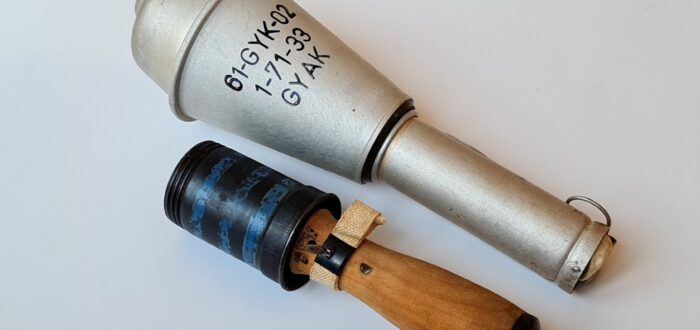Kristóf Nagy
This short article offers a brief, inexhaustive overview of the most common training hand grenades used by Warsaw Pact forces primarily during the Cold War period—although some remain in use today. The training devices featured in this article include examples manufactured by the Soviet Union, Czechoslovakia, Poland, the German Democratic Republic (GDR; East Germany), and Hungary. Note that the only Hungarian device referenced in this publication is the AZ58-K100 anti-tank training grenade; for more information on other Hungarian-made training grenades, see ARES’ 2018 article assessing the Hungarian 42/48 M. hand grenade.
Uchebnaya Ruchnaya Granata (URG)
The Uchebnaya Ruchnaya Granata (URG), or ‘Training Hand Grenade’, was used to train users on the prolific F-1 hand grenade. The weight and shape of the URG are identical to the F-1, as is the manual of arms. A lengthened training variant of the UZRGM fuze containing a black powder charge, marked ‘УЧЕБ’ (an abbreviation for ‘training’), was developed specifically for use in the URG. It features an extended firing pin in order to reach the device’s new primer. The body of the URG contains no explosive filling, instead featuring an additional cavity used to accommodate the longer fuze. With its black powder payload, the URG is able to produce significant noise, some smoke, and even a slight concussive effect if used in a confined space. The URG and its fuze body are reusable.

The devices were painted black, but a white stripe or cross was often added to the device. These models were widely used by most Warsaw Pact forces, including Hungary, Romania, Bulgaria, and Poland. A simplified version without a fuze was produced for simple throwing practice and paramilitary exercises. These inert models occasionally were fitted with a rubber endcap, and often marked with a stripe of red paint. Inert URG devices are known to have been used by the GDR and Poland.

Uchebnaya Ruchnaya Granata Nastupatelnaya (URG-N)
The Uchebnaya Ruchnaya Granata Nastupatelnaya (URG-N), or ‘Training Hand Grenade, Offensive’, was designed to replicate the RGD-5 grenade. Unlike the sheet-metal body of the RGD-5, the URG-N features a cast-metal body. The device contains the same modified UZRGM fuze that is found in the URG, and follows the same black-and-white colouring pattern as the URG. Unlike the URG, the internal cavity of the URG-N was designed to include opening at the bottom of the body to vent pressure and gas. The URG-N is reusable like the URG, requiring only the powder charge to be replaced after each use. The URG-N was used by Soviet forces, and remains in Bulgarian and Russian inventories.

CRG 42
The CRG 42 training hand grenade was developed in Poland to replicate the handling and throwing characteristics of the Soviet RG-42 grenade that was in widespread service throughout the Warsaw Pact. Its design is significantly more complex than that of the URG or the URG-N. The CRG-42 features a detachable base and additional vents. This was done to increase the noise effect of the device and to improve its lifespan by more rapidly reducing internal pressure upon detonation. These grenades were painted black with a red stripe. A red stripe is also used to mark the training fuzes.

A much simpler alternative to the CRG 42, known as the RG-42 Treningowy, also exists to train users on the RG-42 hand grenade. It is clearly marked “Treningowy”, or ‘training’, and uses the same fuze as the CRG 42.

AZ58-K100 trainer
The Hungarian AZ58-K100 anti-tank training grenade is another complex design. The live version of this device featured a hollow charge and was meant to be thrown to land on the top of an enemy vehicle. A spring-loaded parachute in the back of the device was used to ensure that the weapon engaged enemy vehicles at the proper angle. Because the primary purpose of this trainer was to teach proper throwing technique, it does not feature any explosive charge. The grenade is marked, in part, ‘GYAK’, an abbreviation for the Hungarian word gyakorló, meaning ‘training’. The AZ58-K100 trainer is painted silver, while the live version of the device is painted green. Both were operated by the Hungarian armed forces.

RG-CV 5
The Czech RG-CV 5 is a training version of the RG 4 impact grenade. The RG 4 was a successor to the RG 34 impact grenade, featuring an improved fuze and an additional fragmentation sleeve that could be fitted to turn the device into a defensive grenade. The RG-CV 5 was manufactured with components from the RG 4, but can be distinguished from live fire examples by the large hole in the top of the device. It can be reused by replacing the impact fuze.

Vz. 21 Rubber Training Grenade
Rubber replicas of the vz. 21 hand grenade were widely used in Czechoslovakia. An older design, the Czech vz. 21 was used as an offensive and defensive grenade beginning in the 1920s. An inert rubber version of the device was manufactured by specialised rubber production firm Rubena Náchod for training the armed forces. The replicas were also used by youth organisations in Czechoslovakia for pre-military education for several decades.

East German Reusable Training Grenade
In addition to crude training devices used to replicate the F-1 and RDG-5 grenades, the GDR also produced a peculiar training grenade manufactured by the VEB Lehrgeräte- und Reparaturwerk Mittenwalde. It features a firing pin that protrudes from the top of the body and can be manually cocked and secured with a ringed-pin that fits through a hole in the spoon. The entire assembly remains intact after it is thrown, allowing for the easy retrieval of the device. Upon unscrewing the top segment of this training grenade, a special delayed cartridge can be placed into its body to simulate a blast. This cartridge is identical in dimensional shape and layout to the GDR’s 26.5 mm flare gun cartridge. The pressure from the simulated blast escapes the body of the grenade through a hole in the bottom of the device.

Sources
Handgranaten – Beschreibung und Nutzung [‘Hand Grenades: Description and Use’]. A 050/1/482. 1980. Berlin: Ministerrat der Deutschen Demokratischen Republik – Ministerium für Nationale Verteidigung.
Handgranaten der NVA [‘Hand Grenades of the NVA’]. A 250/1/107. 1967. Berlin: Ministerrat der Deutschen Demokratischen Republik – Ministerium für Nationale Verteidigung.
Utasitás és anyagismeret a kézigránátok és gyujtópalackok számára [‘Instructions and Physical Characteristics of Hand Grenades and Incendiary Devices’]. 1951. Budapest: Honvédelmi Miniszerium.
Gebhardt, James F. 1998. The Official Soviet Army Hand Grenade Manual. Boulder: Paladin Press.
Lynn, Darryl W. 2007. The Grenade Recognition Manual, Volume 3: Warsaw Pact. Self-published.
Remember, all arms and munitions are dangerous. Treat all firearms as if they are loaded, and all munitions as if they are live, until you have personally confirmed otherwise. If you do not have specialist knowledge, never assume that arms or munitions are safe to handle until they have been inspected by a subject matter specialist. You should not approach, handle, move, operate, or modify arms and munitions unless explicitly trained to do so. If you encounter any unexploded ordnance (UXO) or explosive remnants of war (ERW), always remember the ‘ARMS’ acronym:
AVOID the area
RECORD all relevant information
MARK the area from a safe distance to warn others
SEEK assistance from the relevant authorities

